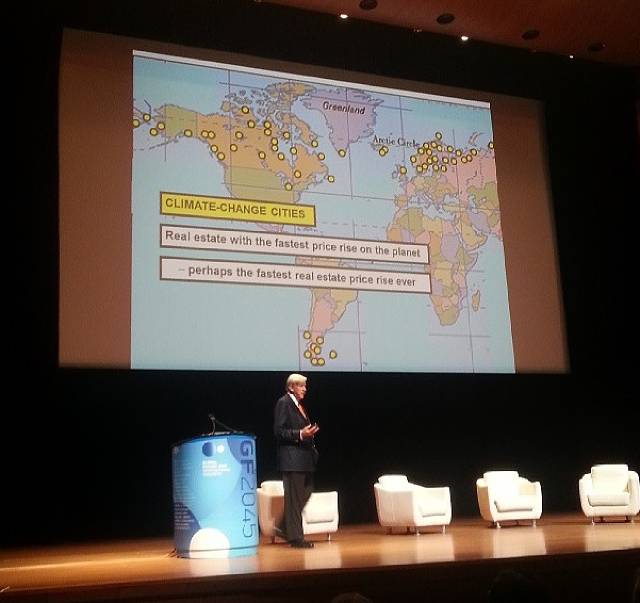Fabulously wealthy British futurist James Martin spoke about climate change at New York?s Lincoln Center and how it will change global population patterns in one of his last public appearances before passing away on June 30 at 79 years of age. Martin, who donated more than $150 million to Oxford University and lived on his own private Bermudan island, believed one of the biggest land booms in history is on its way--and it will happen in less than 100 years.
At the June 15 Global Future 2045 conference, Martin explained that events like Superstorm Sandy and Hurricane Katrina will hit major American cities harder and more frequently because of climate change. Scientists and politicians have even come to the conclusion that whole countries such as Mauritius and Tuvalu will need to evacuate due to rising sea levels. But while coastlines in much of the world may suffer, climate change will be a positive development in some areas. Specifically, Canada; northern Europe; Russia; Alaska; Patagonia, Argentina; and southern Africa may all experience real estate booms. These booms, he claimed, will be in ?Climate Change Cities? with military fortifications catering to an increasingly displaced global elite.

Climate Change Migration
The idea of climate change-triggered mass migration has been around for a long time. Martin?s idea of climate-change cities centers around migration by the upper and upper middle class, but politicians, charities, and bureaucrats worldwide have quietly (and not so quietly) been gearing up for a torrent of refugees fleeing newly inhabitable lands.
This past June, Pacific Ocean island nations hosted a summit on climate change migration where best practices to evacuate thousands upon thousands of people were discussed. For the guests assembled on the island of Rarotonga, the big question was what happens when sea levels rise to a point where island populations simply can?t support themselves. Instead of being discussed as a science fiction hypothetical, the question was treated with steely reality.
What?s At Risk For Cities
As any player of Civilization knows, most major cities anchor trade routes. This means cities are more often than not built seaside or on a riverbank, which puts them at severe risk from rising sea levels. In the United States alone, New York, New Orleans, Chicago, Miami, Boston, San Francisco, Seattle and many other cities face the risk of whole neighborhoods becoming uninhabitable because of climate change. Here in Co.Exist?s hometown of New York City, the Rockaways and large portions of Staten Island and New Jersey are asking themselves just how extensively to rebuild in the wake of Sandy.
Editor?s Note
Research shows that climate change is shrinking the Great Lakes, though the phenomenon is expected to worsen Chicago?s floods.
Continuing with the New York example, Mayor Michael Bloomberg recently proposed a $20 billion climate change plan for the city. The plan is designed to mitigate damage from another Sandy-sized storm and would drastically change everyday life for New Yorkers, with sharply increased taxes and large construction projects in most seaside neighborhoods. But what happens at that unspecified future date when the climate change mitigation plans fail?
Building Climate-Change Cities
Martin?s prediction for the building of climate change cities was pessimistic and stakes itself on growing global instability. These new cities, which would cater to the ?well-heeled,? would be built in places where rising sea levels would actually improve local climates. Rising temperatures and an increase in arable land as a result of climate change is expected to occur in Russia, Canada, Scandinavia, Chile, Argentina, southern Africa, the Great Lakes region of the United States, and far northern and southern zones worldwide. As existing cities and rural regions slowly become uninhabitable due to increasingly inhospitable weather, rising food prices, and skyrocketing utility prices causing a decline in air conditioning, more mass migration is expected.
Alongside conventional worries of security, political autonomy, and economy, the proposed climate change cities would also make use of newer technologies. Self-driving cars, for example, will transform living patterns due to convoy features that sharply reduce both commute times and greenhouse gas consumption. Then there are increasingly energy-efficient methods of producing electricity and growing food--but it?s still unclear if these cities, if they ever come to pass, would be more like Singapore or more of a giant suburban gated community.
Will It Happen?
It?s certainly possible. There is little modern historic precedent for the worst case climate change scenario, where major global cities such as New York and London lose their commercial centers and many residential neighborhoods to rising sea levels. If that indeed comes to pass, frenzied community-building in previously underinhabited regions may occur. But there?s also a more optimistic scenario, where major cities engage in shock construction to mitigate the worst parts of climate change. The two prospects aren?t mutually exclusive. Only the future will tell us what happens.
[Bottom Image: Neal Ungerleider/Instagram]
Source: http://www.fastcoexist.com/1682519/the-climate-change-real-estate-boom-is-coming
florida state meghan mccain wilson chandler bristol motor speedway prometheus grand canyon skywalk tonga
No comments:
Post a Comment
Note: Only a member of this blog may post a comment.